Should I use a Composting Toilet in my Tiny House?
“Yuck, I don’t want to see or smell poo,” is usually the first response to using composting toilets. That’s fair enough, no one does. So it’s good to know that using a composting toilet can be pretty easy and fresh smelling when you’re using them correctly. There are dos and don’ts though, there are pros and cons.
Here is a thorough ‘heads-up’ about what goes down when living with a modern, urine diverting composting toilet in a tiny house.
We use an AirHead composting toilet from A Better Way To Go. So this whole blog is talking about using that specific product, not composting toilets in general.
Background Info: Tiny House Toilet Options
Broadly speaking there are four different styles of toilets to choose from:
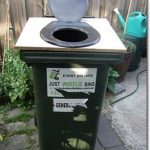 Drop Composting Toilets
Drop Composting Toilets
Everything goes into one tank. Typically you put in sawdust or anything to try to dry it out, but they’re really hard to dry out because there’s usually a lot more wee than poo going into the tank and any moisture at all will make it smell. So they pretty much always smell.
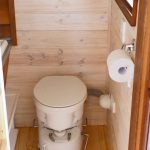 Modern Urine Diverting Composting Toilets
Modern Urine Diverting Composting Toilets
What we’re focusing on in this blog. There are two tanks, one for wee and one for poo, which is separated by gravity and a niftily designed bowl. Keeping the poo tank dry is key to it not smelling and not having to empty it often.
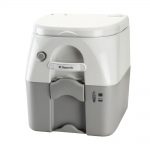 Portable Chemical Toilets for RVs
Portable Chemical Toilets for RVs
Everything goes into one tank that is treated with chemicals. There is a water tank built inside the toilet to use as a flush. The small holding tank, once full, is emptied into a conventional toilet or into a specially designed deposit station, which is done frequently because it fills with water.
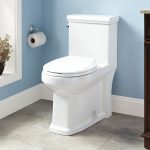 Conventional Toilets
Conventional Toilets
A normal toilet, plumbed into a sewage system or septic tank and flushes with water.
Using Our Modern Urine Diverting Composting Toilet
Smell
There are heaps of factors that go into whether or not a modern urine diverting composting toilet smells. You’d think that its just the presence or absence of poo, but it’s not.
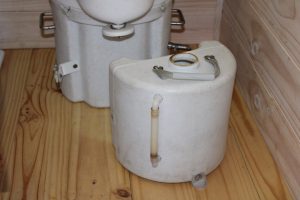 Oddly enough, the poo tank doesn’t smell when it’s being used correctly. The biggest risk factor for the poo tank smelling is if there’s wee in it, so the wee is the problem, not the poo. And the wee tank needs to be emptied out every day or two, but the poo tank only needs to be emptied once every three months with two people using it full time, when using it correctly.
Oddly enough, the poo tank doesn’t smell when it’s being used correctly. The biggest risk factor for the poo tank smelling is if there’s wee in it, so the wee is the problem, not the poo. And the wee tank needs to be emptied out every day or two, but the poo tank only needs to be emptied once every three months with two people using it full time, when using it correctly.
So here are some things that determine whether the toilet smells:
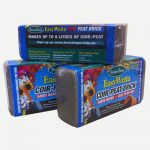 Composting mix – To start off with, the poo tank is filled with damp coco pith and enzymes, which helps the poo to decompose in the tank. Keeping the ratio right is key. Plenty of coco-pith and healthy enzymes is good, plus poo and paper. If there’s not enough coco-pith, the mix will smell. If the enzymes die from using strong cleaning products inside the tank, the mix will smell. But most importantly, if there’s too much moisture in the poo tank, it will smell because it can’t decompose. Which is really what separates a modern urine diverting composting toilet from a simple drop toilet – a modern urine diverting composting toilet funnels the urine away from the poo so that the poo tank contents stays dry and can decompose. Which is essential in a tiny house because there’s nowhere to escape to!
Composting mix – To start off with, the poo tank is filled with damp coco pith and enzymes, which helps the poo to decompose in the tank. Keeping the ratio right is key. Plenty of coco-pith and healthy enzymes is good, plus poo and paper. If there’s not enough coco-pith, the mix will smell. If the enzymes die from using strong cleaning products inside the tank, the mix will smell. But most importantly, if there’s too much moisture in the poo tank, it will smell because it can’t decompose. Which is really what separates a modern urine diverting composting toilet from a simple drop toilet – a modern urine diverting composting toilet funnels the urine away from the poo so that the poo tank contents stays dry and can decompose. Which is essential in a tiny house because there’s nowhere to escape to!
 Cleanliness – Just like any other toilet, the bowl needs to be clean. Unlike other toilets, there are movable parts in the bowl, so if anything gets trapped in the mechanisms, it can start to smell. If toilet paper gets stuck in the movable flap (which is the lid to the poo tank) it can funnel wee into the poo tank, which will make it smell. So checking that the toilet is clean after every use is key.
Cleanliness – Just like any other toilet, the bowl needs to be clean. Unlike other toilets, there are movable parts in the bowl, so if anything gets trapped in the mechanisms, it can start to smell. If toilet paper gets stuck in the movable flap (which is the lid to the poo tank) it can funnel wee into the poo tank, which will make it smell. So checking that the toilet is clean after every use is key.
Use – Guys have to sit down to wee to make the urine diverting function work properly. And in order to keep poo off the toilet bowl, use a paper coffee filter as a bowl liner.
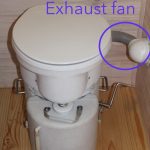 Exhaust fan – There’s an exhaust fan that extracts air from the poo tank and sends it outside, through the external wall. It means that the air flow from the bathroom is always going down into the toilet, instead of the air from the toilet coming up into the bathroom. It’s an important little fan and is best left on!
Exhaust fan – There’s an exhaust fan that extracts air from the poo tank and sends it outside, through the external wall. It means that the air flow from the bathroom is always going down into the toilet, instead of the air from the toilet coming up into the bathroom. It’s an important little fan and is best left on!
So if all these factors are in check, the toilet actually doesn’t smell. Amazing but true! And if it does smell, then it’s operator-error, which can be corrected, so that’s good news.
Becoming Poo Positive!
One of the most difficult things to adjust when using a composting toilet, in my opinion, is your relationship with your poo and wee. We are taught from a young age to be careful not to touch poo, wee or toilets because of the obvious health risks of introducing pathogens into our bacteria pool. But it’s common for people to take this information and other life experiences and get to an experience of being poo-phobic.
But when using a composting toilet, you do have to see your poo. You have to wipe skids off the bowl sometimes without using a long brush on a stick. You just have to get a bit closer to it. You even have to dig a hole and bury the poo every few months.
So it calls for a positive relationship with your poo. Instead of hating it, learn to appreciate it. There’s plenty to like about your poo! It can be returned to the earth to enrich the soil without wasting tonnes of drinking water to transport it to a far away processing plant. That’s pretty good, for sh*t!
Visitors
It’s likely that visitors to your tiny house will not know how to use a modern urine diverting composting toilet, so you’ll probably have to teach them. This is best done when your guests arrive, not when they’re desperate to relieve themselves!
Teaching people about your toilet can be awkward. Even if you’re ok with talking about your poo and wee, you will probably have to teach people who are not so comfortable. Visible instructions and diagrams on the wall are helpful. At the end of this blog you’ll see the instructions that we have made for using our composting toilet in our tiny house AirBnB.
Downloadable file:
Tiny House Composting Toilet Instructions for Visitors
But even with good instructions and the best intentions, things do go wrong and you will probably have to clean other people’s poo occasionally. Not fun. But think of the water you saved! And quality of soil you’ll be able to produce! Dolphins playing merrily in a clean ocean! Ahh, that’s better.
Emptying the Poo Tank
Yeah, it has to be done. If it starts to smell and you’ve checked some of the obvious things: exhaust fan is on, mix looks ok, no obvious cleaning to do in the bowl… and it still smells, you’ll probably have to change the poo contents.
This involves dismantling the toilet, digging a hole and burying the contents of the poo tank. It will smell. You will probably see poo. Then you’ll need to clean the tank. Don’t use bleach, you’ll kill the good bacteria and that will ruin the next batch of compost too. Hose, soap, gloves, grubby clothes, they’re all helpful. Its a great opportunity to clean the top of the toilet as well because you can access the underside of the flap. A brush, soap and gloves will be good. You can also soak it in a bucket if necessary.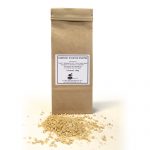
Once it’s clean you can fill the tank with the (pre-soaked and strained) coco-pith and enzymes. Then reassemble the toilet again and enjoy the absence of bad smells in your tiny house, coupled with having really earned your stripes as an environmentally responsible global citizen. Boo-yah!
Pros
- Air Heads look and feel like a conventional toilet.

- They have a really small footprint because the Air Head is the smallest urine diverting composting toilet on the market.
- Using a composting toilet means you don’t have to connect to a sewage system or septic tank, saving you up to $12,000 in connection fees and you can avoid consulting your council about your tiny house placement.
- You get to enrich soil and save water.
- It’s environmentally friendly because there’s no chemicals involved in treating the waste.
Cons
- You get a bit closer to your poo and wee, as described above.

- Maintaining and cleaning the toilet takes time and effort.
- Teaching visitors about the toilet can be awkward and ineffective (visitors may or may not heed your instructions).
- Occasionally, when the toilet isn’t being used correctly, it will smell, which will require attention of the immediate variety, not just the ‘I’ll fix that next week’ variety.
In Summary
While it’s not everyone’s absolute favourite toilet option, a modern urine diverting composting toilet is a great option for tiny house living. It’s in a league above the common drop toilet, because they generally don’t smell, they’re affordable, easy to install and use and they are eco-friendly.
However there’s no amount of reading blogs or brochures that will ever really give you the information that you need to determine whether you can live with a composting toilet in your tiny house. Only experience will give you that. So if you’d like to try it out for yourself, come and stay at our tiny house through Airbnb. Then you can test drive the house and the toilet at once and answer those very personal questions in your own time! 🙂
Resource:
Instructions for Visitors:
Tiny House Composting Toilet Instructions for Visitors







